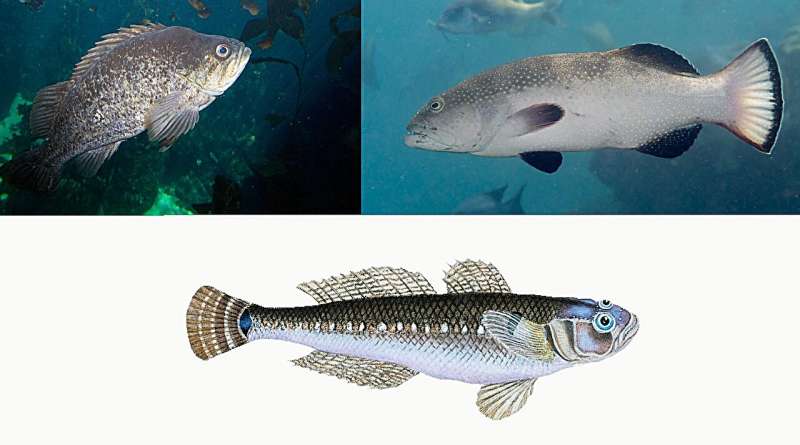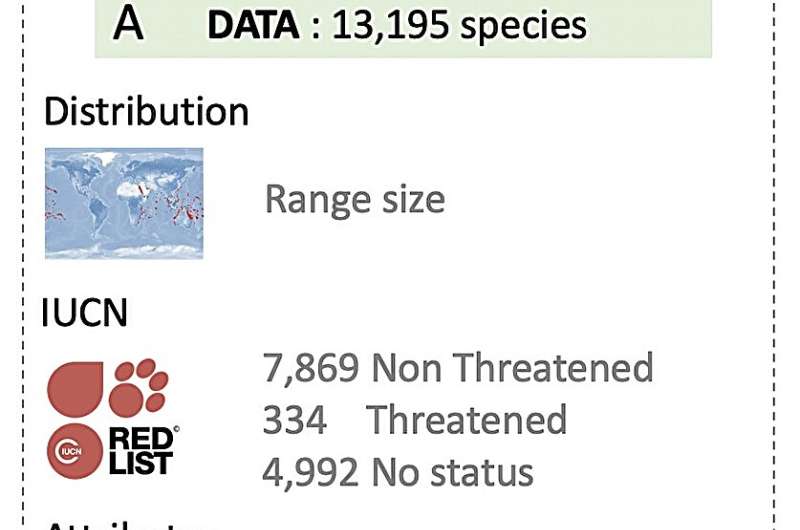This article has been reviewed according to Science X's editorial process and policies. Editors have highlighted the following attributes while ensuring the content's credibility:
fact-checked
peer-reviewed publication
trusted source
proofread
Number of fish species at risk of extinction five-fold higher than previous estimates according to new prediction

Researchers predict that 12.7% of marine teleost fish species are at risk of extinction, up five-fold from the International Union for Conservation of Nature's prior estimate of 2.5%.
Nicolas Loiseau and Nicolas Mouquet from the MARBEC Unit (the Marine Biodiversity, Exploitation and Conservation Unit) in Montpellier, France, and colleagues report these findings in a study published August 29 in the open-access journal PLOS Biology. Their report includes nearly 5,000 species that did not receive an IUCN conservation status due to insufficient data.
The IUCN's Red List of Threatened Species tracks more than 150,000 species to guide global conservation efforts on behalf of the most threatened. However, 38% of marine fish species (or 4,992 species at the time of this research) are considered Data-Deficient and do not receive an official conservation status or the associated protections.
To better direct conservation efforts toward the species that need them, Loiseau and colleagues combined a machine learning model with an artificial neural network to predict the extinction risks of Data-Deficient species. The models were trained on occurrence data, biological traits, taxonomy and human uses from 13,195 species.
They categorized 78.5% of the 4,992 species as Non-Threatened or Threatened (which includes Critically Endangered, Endangered and Vulnerable IUCN categories). Predicted Threatened species increased five-fold (from 334 to 1,671) and predicted Non-Threatened species increased by a third (from 7,869 to 10,451).
Predicted Threatened species tended to have a small geographic range, large body size and low growth rate. The extinction risk was also correlated with shallow habitats. The South China Sea, the Philippine and Celebes Seas and the west coasts of Australia and North America emerged as hotspots for predicted Threatened species. The researchers recommend increased research and conservation efforts in these areas.

The researchers observed "a marked change in conservation priority ranking after species IUCN predictions," recommending that the Pacific Islands and Southern Hemisphere's polar and subpolar regions be prioritized to account for emerging at-risk species. Many species that remained Data-Deficient occur in the Coral Triangle, indicating that additional research is needed there.
The researchers note that models cannot replace direct evaluations of at-risk species, but AI offers a unique opportunity to provide a rapid, extensive and cost-effective evaluation of extinction risk of species.
Loiseau adds, "Artificial Intelligence (AI) enables the reliable assessment of extinction risks for species that have not yet been evaluated by the International Union for Conservation of Nature (IUCN).
"Our analysis of 13,195 marine fish species reveals that the extinction risk is significantly higher than the IUCN's initial estimates, rising from 2.5% to 12.7%. We propose to incorporate recent advancements in forecasting species extinction risks into a new synthetic index called 'predicted IUCN status.' This index can serve as a valuable complement to the current 'measured IUCN status.'"
More information: ring the extinction risk of marine fish to inform global conservation priorities, PLoS Biology (2024). DOI: 10.1371/journal.pbio.3002773
Journal information: PLoS Biology
Provided by Public Library of Science



















